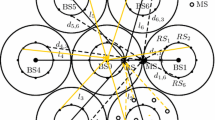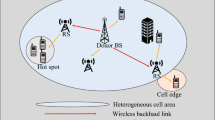Abstract
Relay deployments promise to alleviate the limitations of conventional macrocell networks, such as poor indoor penetration and coverage holes in a cost-efficient way. In this context, the capacity of the wireless relay link between a relay node (RN) and its serving base station has a crucial impact on the end-to-end performance. The deployment flexibility of RNs, which mainly stems from the wireless relay link, compact physical characteristics, and low-power consumption, can be exploited by relay site planning (RSP) to overcome the limitations of the relay link and, thus, enhance the system performance. To this end, RSP is carried out via selecting an RN deployment location from a discrete set of alternatives considering the signal-to-interference-plus-noise ratio (SINR) on the relay link as the selection criterion. In practice, the so-called coarse RSP takes into account only large-scale fading due to shadowing. Nevertheless, as RNs are stationary, the wireless channels pertaining to relay deployments are subject to simultaneous impairments by both shadowing and multi-path fading, i.e., composite fading/shadowing. In this paper, we present the performance of coarse RSP that can be used for planning and dimensioning of two-hop cellular relay networks in composite fading/shadowing environments, where co-channel interference is also present. The relay link is modeled by Nakagami-lognormal distribution while the access link between a mobile terminal and its serving RN is modeled by Rician-lognormal distribution. Further, we provide an accurate analytical framework through closed-form expressions for relay link SINR, link rates, and end-to-end rate. Results show that coarse RSP can still yield high performance improvements in terms of both SINR and rate considering composite fading/shadowing channels. Moreover, coarse RSP is shown to effectively decrease the amount of fading on the relay link and, thus, mitigate the detrimental effects of composite fading/shadowing.








Similar content being viewed by others
Notes
The abscissas and weight factors can be also generated via various online tools like in [29] for \(N\) up to 100.
Recall that the variables \(\left\{ \widetilde{\varUpsilon }_{m,k}:m\ne n\right\} \) are assumed to be independent based on the discussion in Sect. 3.2.2 where uncorrelated shadowing is assumed among the different candidate RN locations.
MATLAB is utilized in AoF evaluations after RSP.
References
Recommendation ITU-R, “Detailed specifications of the terrestrial radio interfaces of International Mobile Telecommunications Advanced (IMT-Advanced)”, ITU-R, Technical Report M. 2012, January 2012.
R. Schoenen, W. Zirwas, and B. H. Walke, “Capacity and coverage analysis of a 3GPP-LTE multihop deployment scenario”. In: IEEE International Conference on Communications Workshops, 2008. ICC Workshops 2008, Beijing, China, May 2008.
A. Bou Saleh, S. Redana, J. Hämäläinen, and B. Raaf, “On the coverage extension and capacity enhancement of inband relay deployments in LTE-Advanced networks,” Journal of Electrical and Computer Engineering, vol. 2010, pp. 1–12, 2010, article ID 894846.
Ö. Bulakci, S. Redana, B. Raaf, and J. Hämäläinen, “Impact of power control optimization on the system performance of relay based LTE-Advanced heterogeneous networks”, Journal of Communications and Networks, vol. 13, no. 4, pp. 345–359, Aug. 2011.
Ö. Bulakci, A. Awada, A. Bou Saleh, S. Redana, and J. Hämäläinen, “Automated uplink power control optimization in LTE-Advanced relay networks,” EURASIP Journal on Wireless Communications and Networking, vol. 2013, no.8, pp. 1–19, Jan. 2013.
E. Lang, S. Redana, and B. Raaf, “Business impact of relay deployment for coverage extension in 3GPP LTE-Advanced”. In: IEEE International Conference on Communications Workshops, 2009. ICC Workshops 2009, Dresden, Germany, June 2009.
K. Doppler, S. Redana, M. Wodczak, P. Rost, and R. Wichman, “Dynamic resource assignment and cooperative relaying in cellular networks: Concept and performance assessment”, EURASIP Journal on Wireless Communications and Networking, 2009, pp. 1–14. Article ID 475281. [Online]. Available: http://jwcn.eurasipjournals.com/content/2009/1/475281, 2009.
P. Moberg, P. Skillermark, N. Johansson, and A. Furuskar, “Performance and cost evaluation of fixed relay nodes in future wide area cellular networks”. In: IEEE 18th Annual International Symposium on Personal, Indoor and Mobile Radio Communications, 2007. PIMRC 2007, Athens, Greece, September 2007.
B. Timus, “Cost analysis issues in a wireless multihop architecture with fixed relays”. In: IEEE 61st Vehicular Technology Conference, 2005. VTC 2005-Spring, Stockholm, Sweden, May 2005.
Nokia Siemens Networks (NSN) and Nokia, “Selection criteria for relay site planning”, 3GPP Technical Specification Group Radio Access Network Working Group 1, Los Angeles, USA, Technical Report R1–092563, June 2009.
Technical Specification Group (TSG) Radio Access Network, “Evolved universal terrestrial radio access (E-UTRA); Further advancements for E-UTRA physical layer aspects (Release 9)”, 3GPP, Technical Report 36.814 v9.0.0, March 2010.
Ö. Bulakci, S. Redana, B. Raaf, and J. Hämäläinen, “Performance enhancement in LTE-Advanced relay networks via relay site planning”. In: IEEE 71st Vehicular Technology Conference, 2010. VTC 2010-Spring, Taipei, Taiwan, May 2010.
A. Bou Saleh, Ö. Bulakci, J. Hämäläinen, S. Redana, and B. Raaf, “Analysis of the impact of site planning on the performance of relay deployments”, IEEE Transactions on Vehicular Technology, Vol. 61, no. 7, pp. 3139–3150, 2012.
Ö. Bulakci, A. Bou Saleh, J. Hämäläinen, and S.Redana, “Performance analysis of relay site planning over composite fading/shadowing channels with co-channel interference,” IEEE Transactions on Vehicular Technology, vol. 62, no. 4, pp.1692–1706, 2013.
Ö. Bulakci, J. Hämäläinen, and E. Schulz, “Performance of coarse relay site planning in composite fading/shadowing environments”, In: IEEE 24th Annual International Symposium on Personal, Indoor and Mobile Radio Communications, 2013. PIMRC 2013, London, UK, September 2013.
G. Stüber, Principles of mobile communication. 2nd ed. Kluwer Academic Publishers, MA, USA, 2001.
M. Simon and M. Alouini, Digital communication over fading channels. 2nd ed. New York: John Wiley & Sons Inc., 2005.
A. Abdi, W. Lau, M.-S. Alouini, and M. Kaveh, “A new simple model for land mobile satellite channels: first- and second-order statistics”, Wireless Communications, IEEE Transactions on, vol. 2, no. 3, pp. 519–528, May 2003.
J. Paris, “Closed-form expressions for rician shadowed cumulative distribution function”, Electronics Letters, vol. 46, no. 13, pp. 952–953, 2010.
S. Atapattu, C. Tellambura, and H. Jiang, “A mixture gamma distribution to model the SNR of wireless channels”, Wireless Communications, IEEE Transactions on, vol. 10, no. 12, pp. 4193–4203, Dec. 2011.
A. J. Viterbi, A. M. Viterbi, K. Gilhousen, and E. Zehavi, “Soft handoff extends CDMA cell coverage and increases reverse link capacity”, Selected Areas in Communications, IEEE Journal on, vol. 12, no. 8, pp. 1281–1288, Oct. 1994.
I. Trigui, A. Laourine, S. Affes, and A. Stephenne, “Performance analysis of mobile radio systems over composite fading/shadowing channels with co-located interference”, Wireless Communications, IEEE Transactions on, vol. 8, no. 7, pp. 3448–3453, July 2009.
I. Petrovic, M. Stefanovic, P. Spalevic, S. Panic, and D. Stefanovic, “Outage analysis of selection diversity over rayleigh fading channels with multiple co-channel interferers”, Telecommunication Systems, pp. 1–12. [Online]. Available: doi:10.1007/s11235-011-9438-z, 2011
Ö. Bulakci, Z. Ren, C. Zhou, J. Eichinger, P. Fertl, and S. Stanczak, “Dynamic nomadic node selection for performance enhancement in composite fading/shadowing environments”. In: IEEE Vehicular Technology Conference, 2014. VTC 2014-Spring, Seoul, South Korea, pp. 1–5, May 2014.
W. Cheng, “Performance analysis and comparison of dual-hop amplify-and-forward relaying over mixture gamma and generalized-k fading channels”. In: 2013 International Conference on IEEE Wireless Communications & Signal Processing (WCSP), pp. 1–6, 2013.
S. Mukherjee, Analytical Modeling of Heterogeneous Cellular Networks. Cambridge University Press, 2014.
I. Gradshteyn and I. Ryzhik, Table of Integrals, Series and Products. 7th ed. Academic Press Inc., 2007.
M. Abramowitz and I. Stegun, Handbook of mathematical functions with formulas, graphs, and mathematical tables. Dover publications, 1964.
Casio, Nodes and weights of Gauss-Hermite. [Online]. Available: http://keisan.casio.com/has10/SpecExec.cgi?id=system/2006/1281195844, 2012
S. Atapattu, C. Tellambura, and H. Jiang, “Representation of composite fading and shadowing distributions by using mixtures of gamma distributions”. In: IEEE Wireless Communications and Networking Conference (WCNC), 2010, pp. 1–5, April 2010.
Broadband Wireless Access Working Group, “Multi-hop relay system evaluation methodology (channel model and performance metric)”, IEEE 802.16m, Technical Report 06/013r3. [Online]. Available: http://www.ieee802.org/16/relay/docs/80216j-06_013r3.pdf, February 2007.
Ö. Bulakci, J. Hämäläinen, A. Bou Saleh, S. Redana, and B. Raaf, “Impact of preconditioning on the convergence of numerical co-channel interference approximations in heterogeneous networks”, In: IEEE 7th International Wireless Communications and Mobile Computing Conference (IWCMC, 2011), pp. 119–124, July 2011.
P. Shankar, “Performance analysis of diversity combining algorithms in shadowed fading channels”, Wireless Personal Communications, vol. 37, no. 1, pp. 61–72, 2006.
Acknowledgments
Part of this work has been performed in the framework of the FP7 project ICT-317669 METIS, which is partly funded by the European Union. The authors would like to acknowledge the contributions of their colleagues in METIS, although the views expressed are those of the authors and do not necessarily represent the project. This work was supported in part by Academy of Finland (Grant 254299).
Author information
Authors and Affiliations
Corresponding author
Rights and permissions
About this article
Cite this article
Bulakci, Ö., Hämäläinen, J. & Schulz, E. Practical Coarse Relay Site Planning: Performance Analysis Over Composite Fading/Shadowing Channels. Int J Wireless Inf Networks 21, 249–261 (2014). https://doi.org/10.1007/s10776-014-0254-8
Received:
Accepted:
Published:
Issue Date:
DOI: https://doi.org/10.1007/s10776-014-0254-8




